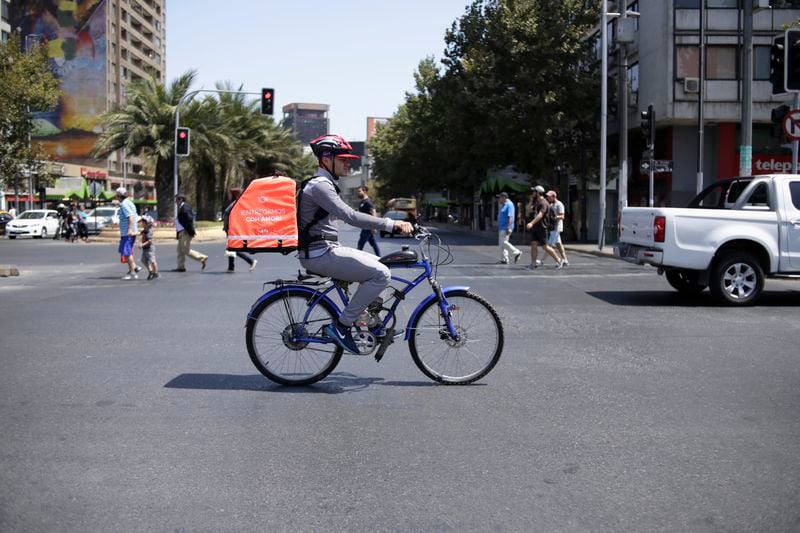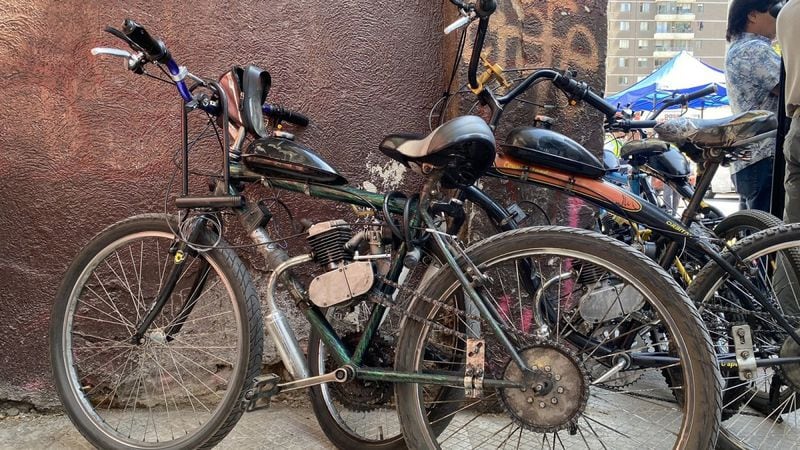Despite the control plan and the efforts of the authorities to remove modified combustion engine bicycles from the streets, they continue to move. And it is that in addition to being easy to acquire, they are cheaper and therefore the “working tool” of many delivery people.
They announce their arrival with a loud sound, similar to the buzzing of a mosquito, but at an excessive volume, and leave behind an invisible smoke, with a strong odor that can irritate the mucous membranes of whoever inhales it. These are the mosquito bikes, modified bikes that run with an additional combustion engine, which makes it possible to pedal easily and travel long distances at low cost.
But its existence represents a headache for cyclists and the authorities. “It is a serious problem, which has aspects of safety, pollution and health that we cannot allow”, underlined the Minister of Transport and Telecommunications (MTT), Juan Carlos Muñoz, announcing that he s is “a totally extraordinary vehicle”. , He cannot circulate.”
Despite the fact that the supervisory ministry assured that a “systematic control” would be carried out from December 2022 to withdraw them from circulation, in this first quarter of 2023 their characteristic engine is still heard and we see them sharing the exclusive route for conventional bicycles, skipping the road coexistence standard.

The danger of a mosquito-bike on public roads
According to MTT data, dual-drive mosquito bikes pollute between 30 and 50 times more than the engine of a passenger car. Another study by the Catholic University revealed that the concentration of hydrocarbons and carbon dioxide is 100 times higher than the gases emitted by a car.
And it is that this smoke that they release in their path is carbon dioxide, classified by medicine as “a silent and invisible murderer” which is extremely harmful for those who are exposed to inhaling it. In addition, in terms of noise, they twice exceed the permissible norm for cars.
“Although they are small engines, they have a concentration of gases harmful to health (…) They are rustic engines, they have no catalyst, they mix gasoline with ‘oil,” explained Ricardo Hurtubia, UC Transportation Engineering scholar and Cedeus researcher, to Radio Biobío.
But to these risks are added those of speed: a mosquito-bike can easily reach 50 kilometers per hour, and even in the Facebook groups of the communities of “moskiteros”, as they call themselves, they sell motors up to 66 kilometers. kilometers per hour.

From the municipality of Providencia, they specify that “bicycles are the only ones that can circulate on cycle paths, so so-called ‘mosquito’ bicycles or scooters that exceed 25 km/h cannot do so”.
Compared to mosquito engines, a traditional bicycle travels an average of 21 kilometers per hour and reaches a maximum of 40, which is why they are easily overtaken by these vehicles, mainly on cycle paths, being forced to inhale the pollutants that they they leave accelerating. .
“Because of the speed reached by these mosquito bikes, one doubts their ability to brake, because these bikes do not have a very efficient braking system. They use pad brakes, which wear out quickly at because of the same speed at which they move,” he explains to The third Ivan Antonucci cyclist and content creator.
“They are not only a danger for bicycles traveling on cycle paths or for cars on the streets, but also for pedestrians. They use public roads as they please,” adds the young man who went viral on TikTok for criticizing the lack of control of this type of vehicle.
The ease of obtaining a vehicle that is not authorized
There is no doubt that the work of a delivery man, who has to cover several kilometers a day, can benefit from a vehicle that requires less physical effort. On the market, there are more sustainable options, such as electric scooters and bicycles, in a price range that ranges from 450,000 Chilean pesos to more than 3 million.
But prices for mosquito-bikes, which are practically a conventional bicycle with the anatomy to attach a combustion engine, range from 170,000 to 600,000, which will depend on whether you buy one already assembled or buy the parts separately for assemble it at home. It is because of these lower prices that many dealerships opt for this option when choosing their work tool.

And it is that on the Internet pages, such as YouTube, there are hundreds of tutorials to achieve it, in addition to online stores and even retail stores, such as Paris, Falabella or Mercado Libre, which sell engines and unrestricted items – some even with free shipping – so you can put one together easily.
in conversation with The third the Minister of Transport and Telecommunications, Juan Carlos Muñoz, said that the sale of the mosquito bike or the armed packs, do not fall under the supervision of the ministry, however, “the appeal that we can make to Those who wish to invest in non-homologated vehicles should not do so.These types of spell vehicles are prohibited, so those who use them risk having the motorcycle confiscated and/or fines.
LT He tried to contact the owner of a popular workshop that has been selling and repairing this type of vehicle for over 20 years, but the man preferred to remain silent.
Delivery and the mosquito-bike
Although the MTT has established that those who drive these vehicles must have a license, a circulation permit, an up-to-date technical inspection, compulsory insurance and, in addition, have a class C driving license, there is no authorized mosquito-bike model, if technically they cannot, under any circumstances, circulate on public roads. Indeed, Minister Juan Carlos Muñoz explains that for them, mosquito-bikes are not bicycles: “If they have a combustion engine, they are motorcycles. And since they are spell vehicles, they are impossible to homologate.
“It cannot be that the delivery is made at the price of pollution, at the price of noise, at the price of health,” the authority had previously told shipping companies that operate in Chile, which did not publish. no statement since their release. .announced this Control Settlement. On this occasion, he also specifies that delivery companies must be more demanding and “should be responsible for the vehicle used to distribute their products, that is to say that they comply with regulations and documentation”.
The third consulted the Chilean Association of Mobility Platforms (Achiplam), a union that includes delivery companies such as Rappi and DiDi, but they preferred not to raise the issue until they had analyzed it “more depth”.
“There is a responsibility of the applications, which connect the delivery drivers to the customers. They ignore the mode of transport in which their delivery people deliver the orders. They do a very important job, it’s good that they travel in small transports, but these (mosquito bikes) have a high social cost,” Huturbia said.
“If they could swap those two-strokes for e-bikes, if they had support to recharge the batteries, we could have something super virtuous,” he added.

Control progress
“The objective is to continue to coordinate this type of operation and to detect those who do not respect the highway code”, they declare from the municipality of Santiago, in addition to positively evaluating the control they carry out with the Carabinieri and the MTT.
“We believe that systematic and permanent follow-up gives us good results.” And it is that the municipality, within the framework of the Protected Streets Plan (an initiative of the ministry to enforce traffic regulations), reports that to date it has dealt with 13,847 traffic violations against different vehicles, including mosquito bikes.
Marcela Ortiz, director of supervision of the Municipality of Providencia, told LT that they carry out weekly operations of removal of motorcycles, at critical points of agglomeration of delivery people and near bicycle paths, in order to control this type. of offence.
However, she recognizes that “municipal inspectors have very limited powers, since, to impose a fine, the offender must be identified, and inspectors are not authorized to require an identity card”. This means that, for a correct control, the presence of carabinieri is necessary.
In addition, he reports that “the operation concerns all types of vehicles, however, it focuses on vehicles that may be associated with crimes with social connotations”. They are: homicide, assault, rape, robbery, robbery, robbery, and drug law violations.

“People don’t comply or respect the rules”
Regarding the obvious difficulty of framing these unauthorized vehicles, Emilio Moyano, from the Faculty of Psychology at the University of Talca, explains to LT that “in general, this country is anomic. In other words, people don’t conform, they don’t respect the rules and it’s a complex cultural process where the respect for the rule, the respect for authority, has deteriorated”.
In social media groups, where communities of mosquito-bike riders form, it is common to read advice and jokes on how to evade controls: “It’s just getting lucky and trying to pedal in front of the cops”, “It’s a TV show, after this no one is going to check” or “let them catch me if they can”.
One member even shared a video in which they attack Sergio Berni, Minister of Security for the province of Buenos Aires, and wrote: “What should happen to the Chilean Minister of Transport…seeking to demonize mosquito bikes.
In addition, they constantly notify where the inspection teams are and recommend the use of the Waze application, where you can report and even send notifications with the exact address where the police are.
“It goes without saying that we are in a terribly complex field of crime and that there is nothing but a total disregard for the norm”, adds the psychologist and road safety expert.
Source: Latercera
I am David Jack and I have been working in the news industry for over 10 years. As an experienced journalist, I specialize in covering sports news with a focus on golf. My articles have been published by some of the most respected publications in the world including The New York Times and Sports Illustrated.


